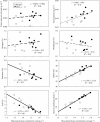Construction costs and physico-chemical properties of the assimilatory organs of Nepenthes species in Northern Borneo
- PMID: 17452380
- PMCID: PMC2802909
- DOI: 10.1093/aob/mcm023
Construction costs and physico-chemical properties of the assimilatory organs of Nepenthes species in Northern Borneo
Abstract
Background and aims: Species of the Nepenthaceae family are under-represented in studies of leaf traits and the consequent view of mineral nutrition and limitation in carnivorous plants. This study is aimed to complement existing data on leaf traits of carnivorous plants.
Methods: Physico-chemical properties, including construction costs (CC), of the assimilatory organs (leaf and pitcher) of a guild of lowland Nepenthes species inhabiting heath and/or peat swamp forests of Brunei, Northern Borneo were determined.
Key results: Stoichiometry analyses indicate that Nepenthes species are nitrogen limited. Most traits vary appreciably across species, but greater variations exist between the assimilatory organs. Organ mass per unit area, dry matter tissue concentration (density), nitrogen (N), phosphorus (P), carbon, heat of combustion (H(c)) and CC values were higher in the leaf relative to the pitcher, while organ thickness, potassium (K) and ash showed the opposite trend. Cross-species correlations indicate that joint rather than individual consideration of the leaf and the pitcher give better predictive relationships between variables, signalling tight coupling and functional interdependence of the two assimilatory organs. Across species, mass-based CC did not vary with N or P, but increases significantly with tissue density, carbon and H(c), and decreases with K and ash contents. Area-based CC gave the same trends (though weaker in strength) in addition to a significant positive correlation with tissue mass per unit area.
Conclusions: The lower CC value for the pitcher is in agreement with the concept of low marginal cost for carnivory relative to conventional autotrophy. The poor explanatory power of N, P or N : P ratio with CC suggests that factors other than production of expensive photosynthetic machinery (which calls for a high N input), including concentrations of lignin, wax/lipids or osmoregulatory ions like K(+), may give a better explanation of the CC variation across Nepenthes species.
Figures


References
-
- Adam JH. Reproductive biology of Bornean Nepenthes (Nepenthaceae) species. Journal of Tropical Forest Science. 1998;10:456–471.
-
- Adamec L. Mineral nutrition of carnivorous plants – a review. Botanical Reviews. 1997;63:273–299.
-
- Albert VA, Williams SE, Chase MW. Carnivorous plants: phylogeny and structural evolution. Science. 1992;257:1491–1495. - PubMed
-
- An C-II, Fukisaki E-I, Kobayashi A. Plasma membrane H+-ATPases are expressed in pitchers of the carnivorous plant. Nepenthes alata Blanco. Planta. 2001;212:547–555. - PubMed
-
- Helrich K, editor. AOAC. Official methods of analysis. 15th edn. Vol. 1. Arlington, VA: Association of Official Analytical Chemists; 1990.
Publication types
MeSH terms
Substances
LinkOut - more resources
Full Text Sources
Research Materials
Miscellaneous

